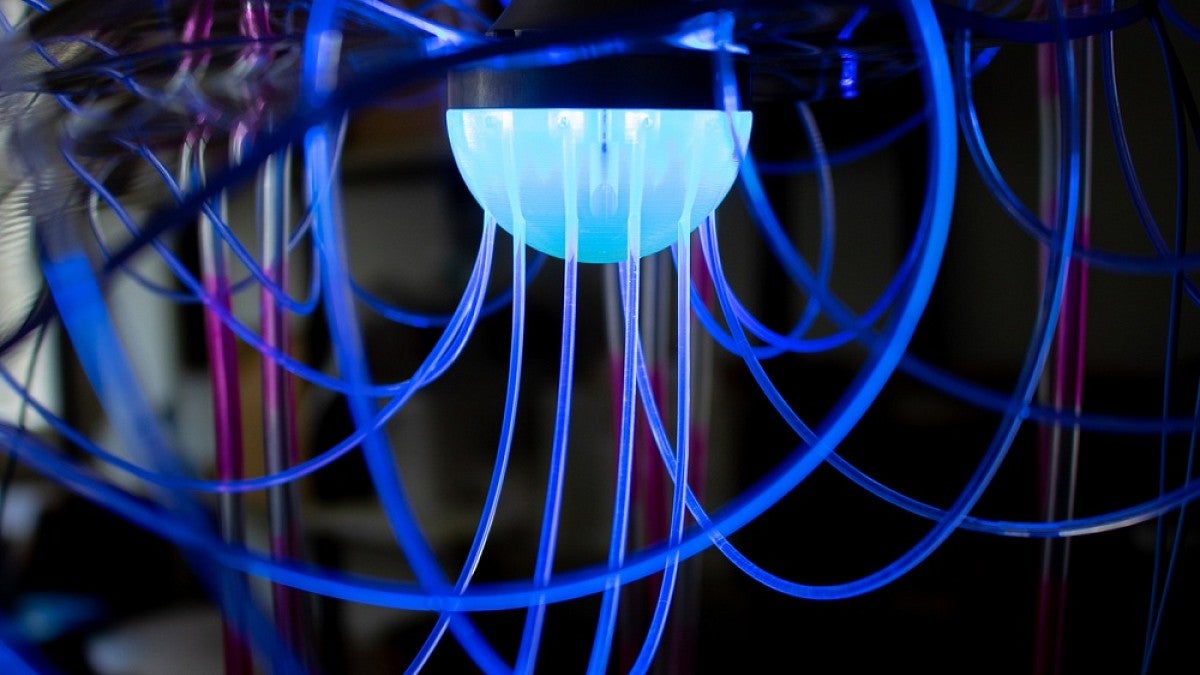She is a groundbreaking new media artist and STEM educator. He is a UO doctoral candidate in particle physics. Both are Latin Americans from Miami. And like particles merging together in a divine synergistic dance, science and art collided one evening over a beer at the Falling Sky Deli in Eugene.
In January 2017, Johan Bonilla invited Agnes Chavez to the UO campus to speak to his group, A Community for Minorities in STEM, on breaking down language barriers. Afterward, during a conversation over a beer, the stars and planets aligned.
“After her talk and workshops, we went to Falling Sky and she showed me some of her sketches and also talked to me about a possible project,” Bonilla said. “It was like the perfect storm.”
The feeling was mutual.
“Johan said he was going to CERN for a year,”Chavez said, using the French acronym for the European Organization for Nuclear Research, home of the world’s most powerful particle collider. “And I said, ‘I’m going to be doing an installation there and I’m going to be there!’ I asked him what he specialized in and he told me experimental data and I said, ‘Wow that’s exactly the area that I’m exploring.’”
What happened next was the classic “napkin-sketch-on-a-restaurant-table” story you see in movies, according to Chavez.
“It was like I was drawing my idea and he gets it,” she said. “He starts filling in the blanks. I had the concept but I didn’t really know how the data works and the specifics of the physics and how to actually visualize the data. There were so many things that made us really click. He’s not an artist, but he sees it as a language and he’s able to speak the arts language, but he also speaks the language of physics.
Together, they envisioned “Fluidic Data,” what would become a permanent floor-to-ceiling art installation spanning four levels of the stairwell at the CERN Data Center near Geneva, Switzerland, where the Large Hadron Collider is housed.
As a nontraditional artist and STEM instructor, Chavez said she is drawn to science; physics, in particular: “I am always searching for materials and technologies that can express those ideas,” she said. Her past art installations have explored nature as metaphor by fusing art with science to not only promote learning but also provoke a calming, meditative experience.
To fit into the limited space of the stairwell, the shape of the installation is a very narrow sheet of braided wires that look like plant vines, which cascade down onto the platform at the bottom like a waterfall.
“The concept I wanted was a stand-alone, multisensory, experiential art installation apart from the visualized sciences,” Chavez said. “And Johan became my translator because I so relied on him when I needed to talk to the other physicists at CERN.”
From an artistic perspective the abstract art piece resembles a stylized plant structure complete with twisted vines and flower pods that light up at random intervals. But on closer inspection one can begin to see the hidden science within.
The installation features 56 individual thermoplastic pods each representing a unique particle that behaves in response to real-time data being collected at CERN. Through the interplay of water and light, the pods light up when the particles are traced, helping visitors visualize both real time and archived data coming from the four major LHC experiments ALICE, ATLAS, CMS, and LHCb.
The pattern of “bubbles” within the pods relate to what family of particles they belong to. For instance, pods with three bubbles represent quarks, two bubbles are leptons, no bubbles are bosons.
“The idea was for it to be organic and to look pretty, but the more you analyze it the more detailed information you get,” Bonilla said. “The details are always there, you just have to look for them.”
Chavez said they tried to think of how to use the artwork to communicate and educate people on the variety of particles and why they’re different, but they also used it as a symbolic, visual way to distinguish the particles.
“But the average person doesn’t have to go that deep, they can enjoy it for its aesthetic quality too,” she said.
For those who want to dig a little deeper though, a virtual kiosk will provide interactive information about how the installation visualizes the data, the symbology behind particle visualizations, and the collider run-time conditions, or archived run details, driving the bubble frequency and size for each experiment.
The most rewarding aspect of the project, according to Bonilla, was the opportunity to break out of his comfort zone and collaborate with other team members at CERN.
“Physicists tend to talk just to other physicists; you don’t leave your department building,” he said. “So it was really nice to work and talk with other people and develop relationships.”
As for Bonilla and Chavez, collaboration on “Fluidic Data” is just the beginning. Chavez, who is planning to develop educational activities for her STEM students that incorporate some of the physics technology used in the installation, also hopes to include Bonilla in future information-sharing talks about physics and the art piece.
“I anticipate us working together for many years,” she said.
“Fluidic Data” is scheduled to open at the CERN Data Center in November.
—By Sharleen Nelson, University Communications


